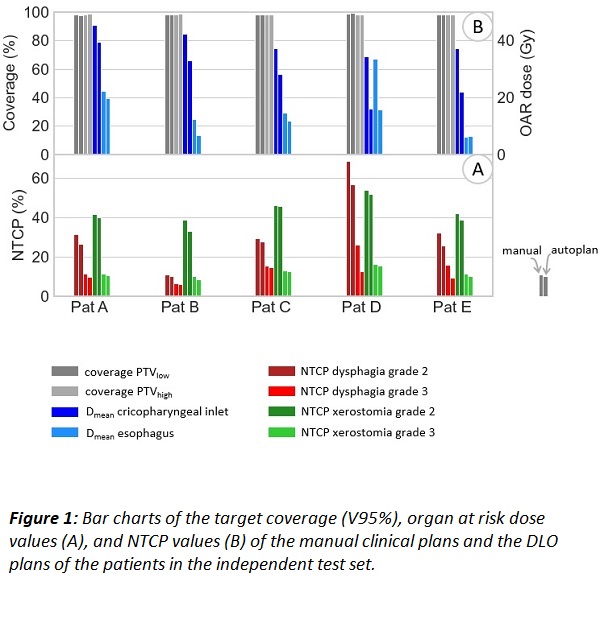Pre-clinical use of deep learning optimization improves plan quality in head and neck VMAT
Antoinette Arents-Huls,
The Netherlands
MO-0144
Abstract
Pre-clinical use of deep learning optimization improves plan quality in head and neck VMAT
Authors: Antoinette Arents-Huls1,1, Marijke de Boer1, Edwin van der Wal1, Dennie Fransen2, Fredrik Löfman2, Bas Kreike1, Roel G.J. Kierkels1
1Radiotherapiegroep, Radiotherapiegroep, Arnhem, The Netherlands; 2RaySearch Laboratories, Machine Learning, Stockholm, Sweden
Show Affiliations
Hide Affiliations
Purpose or Objective
Purpose
Conventional VMAT planning for head and neck cancer (HNC) is a time consuming process and therefore greatly benefits from automation. Recently, automated planning using deep learning dose prediction and dose mimicking optimization (DLO) has been implemented in a commercially available TPS. This enables efficient investigation and optimization of different VMAT parameters and treatment margins on organs at risk (OARs) sparing. The study aim was to improve HNC VMAT plans compared to the manually optimized plans by DLO model configuration, plan parameter optimization and pre-clinical implementation of DLO to provide decision support for dosimetrists.
Material and Methods
Methods
DLO model configuration
The 3D U-Net DLO model was trained at RaySearch Laboratories using 100 oropharyngeal cancer patients treated with a simultaneously integrated boost technique (70 Gy to the primary tumor and 54.25 Gy to the elective region in 35 fractions). Nine oropharyngeal cancer patients treated at our clinic were used to configure the model towards our clinical protocol with a total dose of 68/51 Gy in 34 fractions. Evaluation of the DLO model was performed on an external test set of five different HNC patients. Normal tissue complication probability (NTCP) values for grade 2-3 dysphagia and xerostomia were computed to evaluate the dose to OARs and compare the DLO and clinical plans. OARs not present within the NTCP model were evaluated by comparing the mean dose.
Optimize plan parameters
The validated DLO model was repetitively used to study the effect of planning parameters, i.e. collimator angle, number of arcs and use of non-coplanar arcs.
Pre-clinical implementation
In addition, DLO was implemented pre-clinically to guide the dosimetrist during the planning process. For evaluation, OAR mean dose differences were reported.
Results
Results
The DLO model was successfully configured towards our clinical protocol. The plans of the independent test set were non-inferior to the clinical plans. For these patients, the grade 2 and 3 sum NTCP values decreased by 7.7% (2.2-14.1) and 5.6% (1.3-14.5), respectively (figure 1A). OAR dose reductions up to 50% (Dmean) were achieved for typical clinical cases (figure 1B).
DLO led to efficient evaluation of plan parameter settings, such as increasing the cumulative gantry angle or using non-coplanar beam arrangements which reduced the OAR doses while preserving target coverage. With DLO, quantification of a variety of treatment parameters is at hand and demonstrated the transition from dosimetrist planning-only tasks towards planning protocol tuning activities.
In parallel, the DLO model was successfully implemented as a decision support tool for dosimetrists. The DLO dose triggered the dosimetrists to further optimize the plans without compromising target coverage.
Conclusion
Conclusion
The DLO model for HNC VMAT improves treatment plan quality by efficiently use of DLO model configuration, plan parameter validation and pre-clinical DLO predictions for decision support.